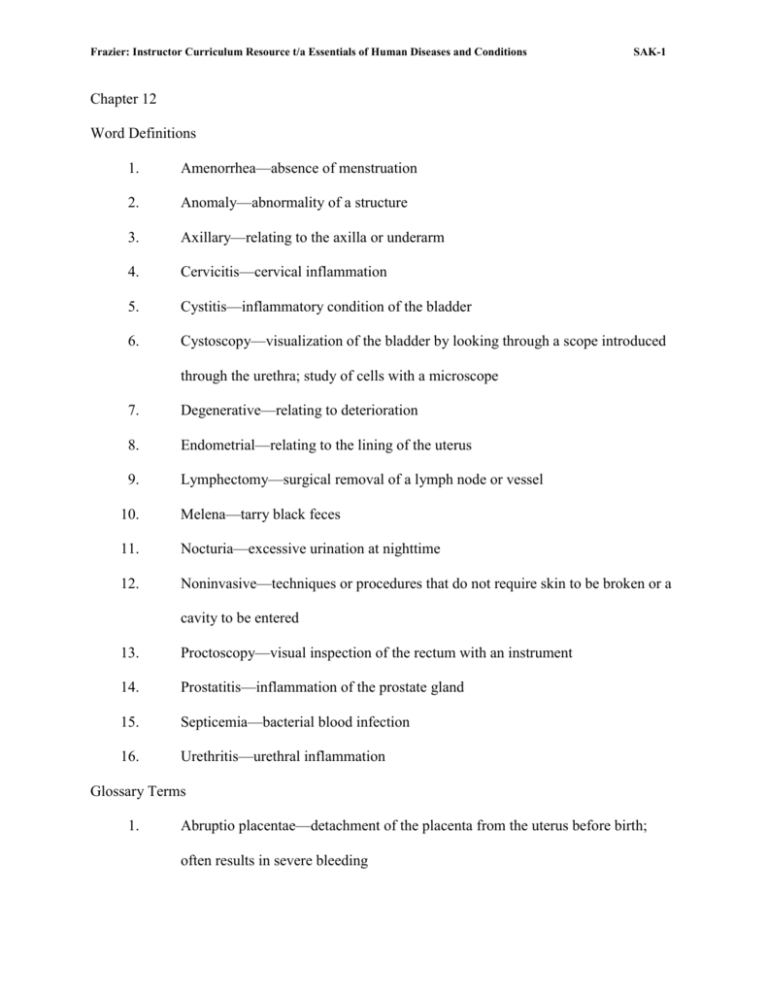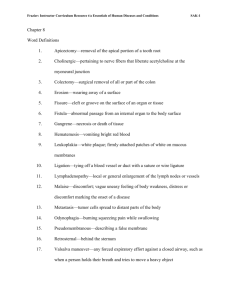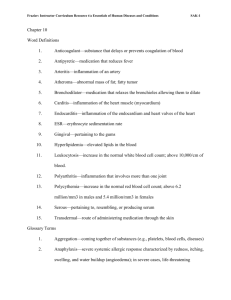ma126-wb_ans_ch121
advertisement

Frazier: Instructor Curriculum Resource t/a Essentials of Human Diseases and Conditions SAK-1 Chapter 12 Word Definitions 1. Amenorrhea—absence of menstruation 2. Anomaly—abnormality of a structure 3. Axillary—relating to the axilla or underarm 4. Cervicitis—cervical inflammation 5. Cystitis—inflammatory condition of the bladder 6. Cystoscopy—visualization of the bladder by looking through a scope introduced through the urethra; study of cells with a microscope 7. Degenerative—relating to deterioration 8. Endometrial—relating to the lining of the uterus 9. Lymphectomy—surgical removal of a lymph node or vessel 10. Melena—tarry black feces 11. Nocturia—excessive urination at nighttime 12. Noninvasive—techniques or procedures that do not require skin to be broken or a cavity to be entered 13. Proctoscopy—visual inspection of the rectum with an instrument 14. Prostatitis—inflammation of the prostate gland 15. Septicemia—bacterial blood infection 16. Urethritis—urethral inflammation Glossary Terms 1. Abruptio placentae—detachment of the placenta from the uterus before birth; often results in severe bleeding Frazier: Instructor Curriculum Resource t/a Essentials of Human Diseases and Conditions 2. SAK-2 Amniotic fluid—transparent albuminous liquid made by the amnion and the fetus; surrounds and protects the fetus during pregnancy 3. Asymptomatic—without symptoms 4. Colporrhaphy—suturing of the vagina 5. Endometrium—lining of the uterus that changes with the menstrual cycle; if the ovum is fertilized, the endometrium serves as the place where implantation occurs 6. Laparoscopy—surgical procedure to examine the abdomen using an endoscope called a laparoscope 7. Neoplasm—abnormal formation of new tissue; can be benign or malignant 8. Nulliparous—woman who has never produced viable offspring 9. Pathologist—one who specializes in the study of disease 10. Peau d’orange—skin is dimpled, resembling the skin of an orange 11. Pelvic inflammatory disease—inflammation of the female pelvic organs, usually caused by bacteria 12. Peritonitis—inflammation of the membrane that lines the abdominal cavity and covers the viscera 13. Prostate-specific antigen—enzyme that is measured in a blood test to detect cancer of the prostate 14. Serologic—study of blood serum to measure antibody titers 15. Zygote—fertilized ovum Short Answer 1. Testes 2. Penicillin G Frazier: Instructor Curriculum Resource t/a Essentials of Human Diseases and Conditions SAK-3 3. Hypertension, edema, proteinuria 4. Nodule or painless swelling of one testicle 5. Pain associated with menses (periods) 6. Mittelschmerz 7. Chlamydia 8. Chemical or surgical removal 9. The placenta that is implanted in the lower uterine segment encroaches on the internal cervical os, causing bleeding 10. Breast cancer 11. Early treatment of urinary tract infection 12. Gentle manipulation of the testicle, surgery 13. Cystitis, dilation of the ureters, pyelonephritis, hydronephrosis, uremia 14. 20 to 35 years 15. Underlying disorder or disease condition including pelvic infections, fibroids, endometriosis, cervical stenosis 16. Noncancerous tumor of the smooth muscle within the uterus 17. Digital rectal exam, prostate-specific antigen (PSA) test 18. Women 19. Reducing the frequency and duration of outbreaks 20. Direct skin to skin contact with an infected person. 21. No 22. 90% 23. 40 to 65 Frazier: Instructor Curriculum Resource t/a Essentials of Human Diseases and Conditions 24. 6th to 12th week 25. Fallopian tube 26. Grand mal seizure, coma, hypertension, proteinuria, edema 27. No 28. Benign Fill in the Blanks 1. ductus deferens, ejaculatory 2. breast, reproduction 3. United States 4. protozoal, lower 5. itch, burn 6. prostate 7. viral, bacterial, injury 8. painful, chronic 9. fibroids, tumors 10. acute, systemic, strains 11. women, 45, 55 12. downward, uterus 13. cystocele, anterior 14. Kegel 15. streptococcal, staphylococcal Anatomic Structures 1. Normal male reproductive system SAK-4 Frazier: Instructor Curriculum Resource t/a Essentials of Human Diseases and Conditions 2. Normal female reproductive system SAK-5 Frazier: Instructor Curriculum Resource t/a Essentials of Human Diseases and Conditions 3. Normal female breast SAK-6 Frazier: Instructor Curriculum Resource t/a Essentials of Human Diseases and Conditions SAK-7 Frazier: Instructor Curriculum Resource t/a Essentials of Human Diseases and Conditions SAK-8 Suggested Responses for Patient Screening 1. Possible trichomoniasis Discomfort associated with the irritating discharge usually prompts a request for an appointment for an examination. Schedule for the next available appointment within 24 hours of the call. If none is available, follow office policy for a referral to a gynecologist or to an urgent care facility. 2. Possible benign prostatic hypertrophy (BPH) A routine physical examination is appropriate to evaluate the BPH. Schedule for an examination at the next available appointment. 3. Possible pelvic inflammatory disease (PID) The patient with fulminating PID reports constitutional symptoms and has significant pain. When symptoms are severe, arrange for immediate medical intervention. Schedule for a same-day appointment or refer to an urgent care facility. 4. Possible miscarriage or abortion Vaginal bleeding and cramping during pregnancy should be immediately reported to the attending physician and the patient directed to prompt medical care. 5. Possible cystic disease of the breast A woman who discovers a breast lump is scheduled for a breast examination. It is important to consider the anxiety she is feeling and schedule as soon as possible, usually on the day of the call. Some physicians consider a recent discovery of a lump in the breast as an emergency. Because of the psychologic affect of the discovery, they want the patient scheduled the same day. Frazier: Instructor Curriculum Resource t/a Essentials of Human Diseases and Conditions SAK-9 Patient Teaching 1. Syphilis Stress the importance of finishing the course of medication, even if symptoms improve. Urge the patient to inform sexual partners of the infection so they can seek treatment if needed. Instruct the patient to avoid all risk factors for sexually transmitted diseases (STDs). 2. Orchitis Review the printed information with the patient. Stress the importance of finishing the entire course of antibiotics as prescribed. Suggest comfort measures such as scrotal support and the use of ice packs. 3. Premenstrual syndrome (PMS) Review the printed information with the patient. Advise her that some women benefit from a stress reduction program or counseling to better cope with symptoms. Assure the patient that an estimated 50% of menstruating women experience PMS in some form. 4. Endometriosis Review the printed information with the patient. Advise adolescents to use sanitary napkins in place of tampons. Review the physician’s advice not to postpone childbearing; offer appropriate referrals. Review any drug therapy as prescribed by the physician. 5. Preeclampsia (toxemia) Review the printed information with the patient and her family. Teach the advantages of early and regular prenatal care to monitor weight, blood pressure, Frazier: Instructor Curriculum Resource t/a Essentials of Human Diseases and Conditions SAK-10 and urinalysis. If a pregnant woman is considered at risk for eclampsia, teach the warning signs to report including sudden weight gain, edema, headache, and increased blood pressure. Early signs can be managed to help prevent hospitalization and the onset of complications. Essay Question Discuss the cause, symptoms and signs, and treatment of premature labor. The cause of premature labor is sometimes unknown. A medical procedure or surgery may be the cause. The predisposing conditions are infection, uterine abnormalities, incompetent cervix, and uterine bleeding. The age of the mother, weight, socioeconomic status, and poor prenatal care may add risk. The symptoms and signs are uterine contractions, spotting, and leaking amniotic fluid. Effacement or dilation of the cervix, which usually occurs in the late second or early third trimester, may be revealed during the vaginal examination or by pelvic ultrasound. The treatment for premature labor is drug administration of magnesium sulfate or terbutaline sulfate (Brethine). Calcium channel blockers, indomethacin, and atosiban may also be used. Certification Examination Review 1. b 2. c 3. d 4. b 5. d 6. c 7. b Frazier: Instructor Curriculum Resource t/a Essentials of Human Diseases and Conditions 8. a 9. a 10. a SAK-11









